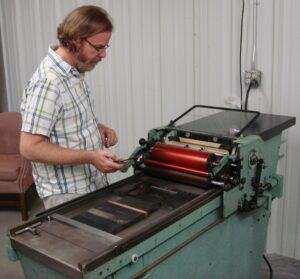
Frank Brannon, printmaking instructor at Oconaluftee Institute for Cultural Arts, applies ink to the newly-arrived letter press that prints Cherokee syllabary. (Photo by Jeff Marley/SCC)
The keystone of the printmaking program, a Challenge Proof Press, arrived at the Oconaluftee Institute for Cultural Arts at 8:45 a.m. on Thursday, Aug. 12.
Although there was no fanfare or ticker tape, this is a monumental event, said Jeff Marley, newly-hired OICA outreach coordinator.
“This marks the first time in 175 years that any school or program in the eastern U.S. has had the capacity to print letter press in Cherokee syllabary,” Marley said.
According to OICA printmaking instructor Frank Brannon, “Work in letterpress printing is conducive to the educational experience that we aspire to at OICA. Our efforts to develop the printmaking studio will support work in Cherokee language revitalization that is ongoing in North Carolina and Oklahoma.”
Brannon continued, “There is much potential to first print in traditional letterpress style in the indigenous language, instructing students in this craft and then have those materials printed by more commercial means to reach a larger audience in support of language revitalization.”
The acquisition of the press was funded through a $68,846 grant from Cherokee Preservation Foundation and a $47,792 grant from the Institute of Museum and Library Services. The staff and Board of Directors began work on the grants and developing plans for a letterpress printing studio in spring 2009. Steve Robinson of Letterpreservation, in Rising Sun, Indiana, was instrumental in assisting in purchasing and delivering the press and additional equipment for the printing studio
Cherokee printing history began in the early nineteenth century with publication of the Cherokee Phoenix newspaper in 1828 in what is today northern Georgia. The story of the early Phoenix is a complex one and is intertwined intimately with the story of the Cherokee of that time. The Phoenix began in the East, stopped publication temporarily during and just before the time of the Trail of Tears, and rose again in Oklahoma in the early 1840s. Sequoyah, having completed development of the contemporary Cherokee writing system only seven years before the advent of the bilingual newspaper, provided the foundation for this first Native American newspaper and a heritage of Cherokee printing.
“We are excited about all the creative possibilities the press opens up for our students and the community,” said Marley. “Our program offers students a chance to experience history while learning how to visually express themselves; the arrival of the letter press adds depth to that.”
Southwestern Community College offers an associate of fine arts degree program at the Oconaluftee Institute for Cultural Arts. For more information about OICA, Southwestern Community College and the program, contact Marley at 828.497.3945; or on the web at southwesterncc.edu/finearts/
Source: SCC release





